I think it's because of the economy of scale in the smaller end stuff. up to 20 or 30 tons maybe, for argument's sake. (Including but not limited to junk, the good brands of light presses are included). Hydraulics are more popular because you get the most force and speed per effort applied. So the parts are rolling out of the factories in large quantities, versus uncommon styles.
Assuming that you already have the stock, you can get a bottle jack for less than the cost of tool wear making a screw.
Yeah, that's what I thought: it's much cheaper to polish a cylinder than to cut a large screw (or rack). Hoses are cheap. Fluids are cheap. Everything in a typical small tonnage press is quite cheap to make; plus they make maybe hundreds of thousands per yer. Like with the small drill presses, a modern hydraulic press is the promise of cheap (universally available) technology fulfilled.
But where is the catch? That's my question.
Nothing prevents that except maybe your willingness to do some engineering calculations to be sure that you're getting what you're shooting for. (...)
If I make one I'll just overbuild it; sort of a safety margin in construction / lifting equipment.
Bottom line: if I get to make it, I'll do it for myself, to my liking. I don't see a problem spending money if I'm spending it on myself...
The H frame presses are the most popular for sure, but there's other takes on that too. Not really in anything practical outside of industry, but the H frames are compact for their rating, take the smallest reasonable amount of material to build for their rating, don't take an undue amount of space for their productivity, are very versatile, and are quite popular, meaning that specialized accessories for pressing tend to be geared towards that design.
The arbor press, when used for general purposes, has a (relatively) small pass through area, BUT, it's pretty wide open. That gives a lot of freedom about what you can get in there. On the other hand, the frame is only so deep, and that's a big limitation. An H frame has no depth restriction on the front or the back, but the sides are kinda always there. That makes it awkward to for example, straighten a long bar.
There seems to be the catch. A C (open) frame press is inherently more expensive than an H (closed) frame. It takes more material to get the same level of structural resistance. But you get easier access in return; more practicality. Even with H frames that use beams on each side and have clearance in the middle, to take in and out a long work piece must cumbersome; specially if it's a heavy one.
Another thing I've noticed is that H frame presses are built out of steel and arbor presses are made of cast iron. As nice as cast iron is for some other applications, I don't really see much benefit here. It makes the tool twice as heavy because cast iron has about half the strength of steel.
So what about an "hybrid v" design? Like two C frames joined at the middle:
Seems like it'd have (some of) the advantages of both kinds of presses.
The bottom line is, what do YOU want to do with this thing, and that'll guide you on to what type is best.
I'd rather have one good press than several. I think people often ignore that space is money too.
Plus I think that a huge press is something you'll spend money only once in life.
And what materials might you have access to? You're not going to buy the steel (forget the hardware and mechanisms) to build a press for what you can buy one for.
Well, I'm not sure that applies in this case. Like I said, an arbor press is usually made of cast iron and weights quite a bit. There is a lot of money on materials alone. With steel you need less materials, plus there is a chance to get them from the junkyard.
Last I checked a Dake 15T press costs 12K so I think this is one of those projects that will actually save you money over buying things readily made. Plus I can just call Dake and order a readily made rack / pinion / ratchet / pawl... it's not like I have to do everything.
how much space do you have?
I have a shop separate from home. Like 50 square meters, but usable space is less discounting the bathroom and a giant concrete closet I built to keep the tools locked. Something in the lines of 30.


